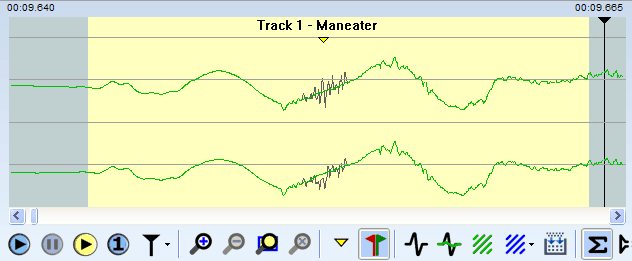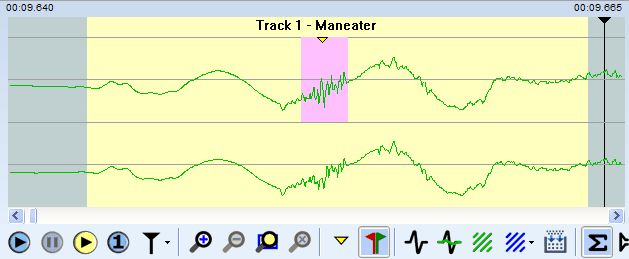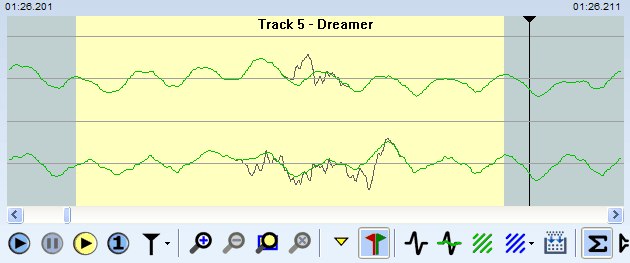

Percussion protection helps prevent the 'dulling' of percussion sounds that declicking can cause, especially at higher sensitivity settings. This happens when VinylStudio concludes (wrongly) that the sharp 'attack' sound of a piece of percussion is a click. This problem is not unique to VinylStudio - other click repair programs are affected in the same way.
Percussion which has been affected in this way usually shows up in the corrections list as a large number of wide clicks (coloured red), especially in loud passages of music. And not only percussion is affected: here is a section of bass guitar, scanned with percussion protection turned off:

As you can see, the corrected (green) trace is missing a lot of the detail present in the original (gray) trace. The result is a dulling of the sound, often unnoticeable but not always. Here's what it sounds like (to hear the difference clearly, you may need to use headphones):
| Original: | |
| Dulled: |
Although we have had to compress these sound samples to reduce the filesize, you can still hear that the 'attack' sound of the bass player's fingers plucking the strings has been lost, which is a shame. If you encounter this kind of problem, you can re-scan the affected area with a higher percussion protection setting, reduce the sensitivity or, if the music is click-free in that area, just use the Remove Corrections option to remove all repairs made by VinylStudio. If you have the patience, you can even delete individual repairs.
In many cases however, percussion protection does its job. Here is a screenshot of the above example with percussion protection enabled:

| And as a result, the original sound is restored: |
The default Percussion Protection setting is set fairly low to avoid clicks from slipping through. If your recording is in reasonable condition, you can probably benefit by using a higher setting than the default. If you are prepared to put some time in, first try the maximum setting as this gives the best sound quality, but be prepared for the odd click to slip through. When this happens, rescan just the affected area at a lower setting. And you can always use 'undo', of course. Preserving the quality of the music while putting up with the occasional click is sometimes the best compromise.
The corrections list can help you identify sections of music where percussion protection is active (or not).
Percussion protection works less well on recordings with a lot of 'scrunches' (i.e. short bursts of clicks in rapid sequence) or scuffs as these look a lot like percussion and can therefore escape detection, so if you are attempting to restore a scratchy old 78 you will probably get better results with percussion protection turned down or turned off. Here is an example where percussion protection has got it wrong (we deliberately used a higher than normal setting to provoke this):

Although the waveform looks like a piece of percussion, it is in fact a scuff on the record surface. In this case, the problem can be resolved by scanning with percussion protection turned to a lower setting:
